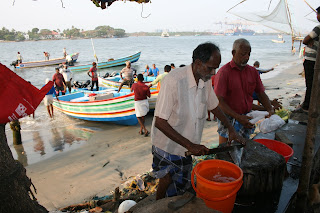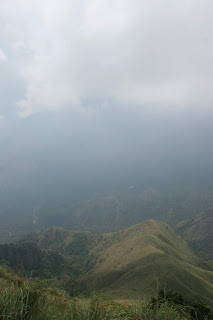The last full day
One of the features of Fort Kochi is its fishing community. We visited the landing place each day, and watched fishermen throwing their nets into the water. The Chinese nets were not in use while we were there, the netters appeared unsuccessful, but boats landed their catches of large fish with much enthusiasm.
 |  |
Gutting the freshly caught fish ready for sale
|
The Chinese nets in Fort Kochi
|
 |
 |
 |
| Landing the catch at Fort Kochi |
Our American friends had enthused about the Kochi arts festival. The Kochi-Muziris Biennale is an international exhibition of contemporary art. It is the largest art exhibition in India and the biggest contemporary art festival in Asia.
It was spread over several sites, and we knew that we would not be able to visit them all, so after an abortive visit to one site, we moved on to the main venue, Aspinwall House. Here we found an amazing eclectic collection of contemporary art. Whilst I cannot claim to have understood everything I saw, there were two or three particularly thought provoking, if not artistically compelling exhibits.
Kerala had been hit by devastating floods the previous year. Our driver, in Munnar, had lost his home in a landslide. These exhibits told the story of the floods through a piles of waterlogged ruined books, and by images of an arts bus that had visited the villages. It told the story of how the fishermen, mainly Christians, had used their boats to take people to safety. If you are planning to visit Kerala, if you are interested in art, then time it for the 2021 Biennale.
In the afternoon, we took the ferry across the harbour and then hired a tuk tuk which carried us to Indriya Sands, in Kuzhuppilly. Our initial destination had been Vypin Lighthouse, but the driver carried us onward. There was nothing there. Nothing but a pristine beach and palm trees. It was glorious, and we sat watching the sun set, before returning to Fort Kochi.
I had thought that we might eat somewhere special on our last night but instead found ourselves in a tiny upstairs room, decorated with murals of Kochi. The food was delicious. A wonderful last supper. However, the loo arrangements were a little odd and involved being taken out into the street and into an adjoining shop, and then through the back into someone's home.
We returned to our room to pack up and prepare for an early departure.
What a wonderful 18 days in Southern India.
































